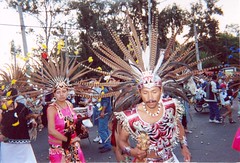
BY DAVID AGREN/Special to The Herald Mexico
El Universal
October 13, 2005
José María Romo, 86, needed a miracle. He broke his lower leg playing soccer in 1941; the bones jutted out through his skin. The injury wouldn't heal properly so his doctor recommended amputating his foot. Romo prayed to the Virgin of Zapopan, asking for intervention.
Today, 64 years later, Romo proudly rolls up his pant leg to show where his doctor wanted to cut.
"I received a miracle," he says. "They didn't cut off my foot."
While most Mexicans observe Día de la Raza on Oct. 12, the day Christopher Columbus arrived in the Americas, much of Jalisco pays homage to the Virgin of Zapopan, watching her return to her suburban Guadalajara home after touring each parish in the local diocese. The Catholic icon perhaps ranks nearly as high in stature for Jalisco residents as the revered Virgin of Guadalupe, a figure deeply entrenched in the national mythology. Each year, more than one million people line an eight-kilometer-parade route, running from Guadalajara's main cathedral to the suburban Zapopan Basilica, taking in colorful indigenous dances and giving thanks for past blessings.
"There's no other event of this kind anywhere else in the republic," Romo said.
Romo grabbed a curbside spot for the early-morning festivities near the Guadalajara-Zapopan border at 6 a.m., but many in the crowd arrived much earlier. With the event regularly drawing so many spectators, many Guadalajara-area businesses close for the day. Most students receive the day off.
Some onlookers like Romo, who marched in the event for eight years as one of the virgin's guards, come to express gratitude or to ask for intervention.
Others venture out for the pageantry.
"We really like the dances," said María Magdalena Hernández, who brought her two sons to the event. "It's a tradition."
FESTIVITIES
Indigenous dancers from across the region, clad in typical costumes, preceded the virgin. Boys, wearing masks and brandishing whips, cleared a path, keeping the overflow crowds off of the route. For more than two hours, drums thumped, metal shoes clanked and whips cracked.
With a massive crowd in attendance, hundreds of vendors set up puestos (stands), hawking everything from food to religious trinkets and photos of the virgin. Product sample wrappers littered the parade route. Tshirt vendor Memo Gutiérrez claimed a prime location at 10 p.m. the night before, calling the annual parade one of his best sales days.
BACKGROUND
The Virgin of Zapopan dates back to the 1540s, when the Spanish arrived in Jalisco. Originally fashioned from corn, the Spanish used the icon, which resembles the Virgin Mary, to pacify rebellious indigenous communities. The virgin allegedly healed the sick, leading the indigenous population to embrace her.
The legend grew after the Virgin of Zapopan, then residing in a specially-built cathedral in the city of the same name, visited nearby Guadalajara, which was under the grip of a terrible plague in the 1720s. The plague disappeared shortly thereafter.
More recently, adherents say the virgin arrested a 10-year decline in Lake Chapala's water level in the 1950s.
Pilgrims from as far away as Guanajuato and Zacatecas regularly travel to Zapopan, looking for intervention. Pope John Paul II paid a visit to the Virgin of Zapopan's home in 1979.
After an endless stream of dancers moved on and to calls of, "Viva Maria," the 20-inch virgin made her appearance, riding under glass on a flower-laden float and accompanied by guards in colonial Spanish costumes.
Tears welled up in José María Romo's eyes as the virgin slowly passed by.
"I feel immense gratitude," he said softly, dabbing his face with a handkerchief.
From the Miami Herald, Mexico Edition, October 13, 2005.


No comments:
Post a Comment